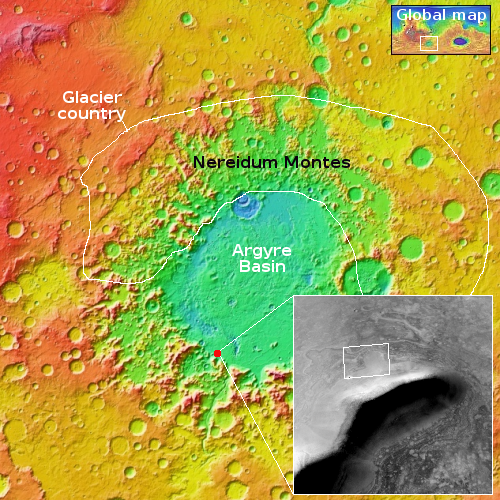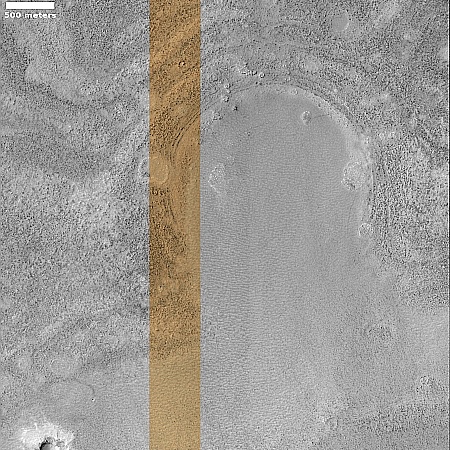Strange flat layers on Mars
Cool image time! The picture to the right, rotated, cropped, reduced, and enhanced to post here, was taken on July 16, 2024 by the high resolution camera on Mars Reconnaissance Orbiter (MRO). It shows what MRO’s camera team labels as “layers near ridge in Argyre Planitia.”
The layers are strange because there is so little topographic difference between them. Though the ground slopes downward from the south to the north, dropping about 1,300 feet, it does so almost smoothly. The layers show relatively little topographic relief.
And what caused the circular shape? Is it evidence of a buried crater? And if so, why so little relief at its rim?
As always, the overview map provides some answers.

The red dot on the map to the right marks the location, in the southwest quadrant of Argyre Basin, one of Mars’ big basins thought to have been created by a large impact several billion years ago. The rectangle in the inset shows the area covered by the picture above. These layers and that circular feature sit at the northern base of a 3,000-foot-high ridge.
The inset also suggests strongly that the circular feature is actually material that flowed down the northern flank of that ridge, pushing into the plain below. This location is at 55 degrees south latitude, where near surface ice on Mars is common. The plains surrounding this ridge in fact look like a frozen ice sheet. When the material slid down the side of the ridge, the heat of transport might have softened that ice-impregnated ground enough to allow the material to push into the plain, creating the circular feature with its relatively flat topography.
As for the layers at the edge of that circular feature, they suggest that there were many layers within that ice sheet that got pushed and compressed when the flow pushed through. More evidence that Mars’ geological history involves many cycles, some seasonal, some annual, some decadal, and some involving many thousands of centuries to play out.
On Christmas Eve 1968 three Americans became the first humans to visit another world. What they did to celebrate was unexpected and profound, and will be remembered throughout all human history. Genesis: the Story of Apollo 8, Robert Zimmerman's classic history of humanity's first journey to another world, tells that story, and it is now available as both an ebook and an audiobook, both with a foreword by Valerie Anders and a new introduction by Robert Zimmerman.
The print edition can be purchased at Amazon or from any other book seller. If you want an autographed copy the price is $60 for the hardback and $45 for the paperback, plus $8 shipping for each. Go here for purchasing details. The ebook is available everywhere for $5.99 (before discount) at amazon, or direct from my ebook publisher, ebookit. If you buy it from ebookit you don't support the big tech companies and the author gets a bigger cut much sooner.
The audiobook is also available at all these vendors, and is also free with a 30-day trial membership to Audible.
"Not simply about one mission, [Genesis] is also the history of America's quest for the moon... Zimmerman has done a masterful job of tying disparate events together into a solid account of one of America's greatest human triumphs."--San Antonio Express-News
Cool image time! The picture to the right, rotated, cropped, reduced, and enhanced to post here, was taken on July 16, 2024 by the high resolution camera on Mars Reconnaissance Orbiter (MRO). It shows what MRO’s camera team labels as “layers near ridge in Argyre Planitia.”
The layers are strange because there is so little topographic difference between them. Though the ground slopes downward from the south to the north, dropping about 1,300 feet, it does so almost smoothly. The layers show relatively little topographic relief.
And what caused the circular shape? Is it evidence of a buried crater? And if so, why so little relief at its rim?
As always, the overview map provides some answers.

The red dot on the map to the right marks the location, in the southwest quadrant of Argyre Basin, one of Mars’ big basins thought to have been created by a large impact several billion years ago. The rectangle in the inset shows the area covered by the picture above. These layers and that circular feature sit at the northern base of a 3,000-foot-high ridge.
The inset also suggests strongly that the circular feature is actually material that flowed down the northern flank of that ridge, pushing into the plain below. This location is at 55 degrees south latitude, where near surface ice on Mars is common. The plains surrounding this ridge in fact look like a frozen ice sheet. When the material slid down the side of the ridge, the heat of transport might have softened that ice-impregnated ground enough to allow the material to push into the plain, creating the circular feature with its relatively flat topography.
As for the layers at the edge of that circular feature, they suggest that there were many layers within that ice sheet that got pushed and compressed when the flow pushed through. More evidence that Mars’ geological history involves many cycles, some seasonal, some annual, some decadal, and some involving many thousands of centuries to play out.
On Christmas Eve 1968 three Americans became the first humans to visit another world. What they did to celebrate was unexpected and profound, and will be remembered throughout all human history. Genesis: the Story of Apollo 8, Robert Zimmerman's classic history of humanity's first journey to another world, tells that story, and it is now available as both an ebook and an audiobook, both with a foreword by Valerie Anders and a new introduction by Robert Zimmerman.
The print edition can be purchased at Amazon or from any other book seller. If you want an autographed copy the price is $60 for the hardback and $45 for the paperback, plus $8 shipping for each. Go here for purchasing details. The ebook is available everywhere for $5.99 (before discount) at amazon, or direct from my ebook publisher, ebookit. If you buy it from ebookit you don't support the big tech companies and the author gets a bigger cut much sooner.
The audiobook is also available at all these vendors, and is also free with a 30-day trial membership to Audible.
"Not simply about one mission, [Genesis] is also the history of America's quest for the moon... Zimmerman has done a masterful job of tying disparate events together into a solid account of one of America's greatest human triumphs."--San Antonio Express-News


